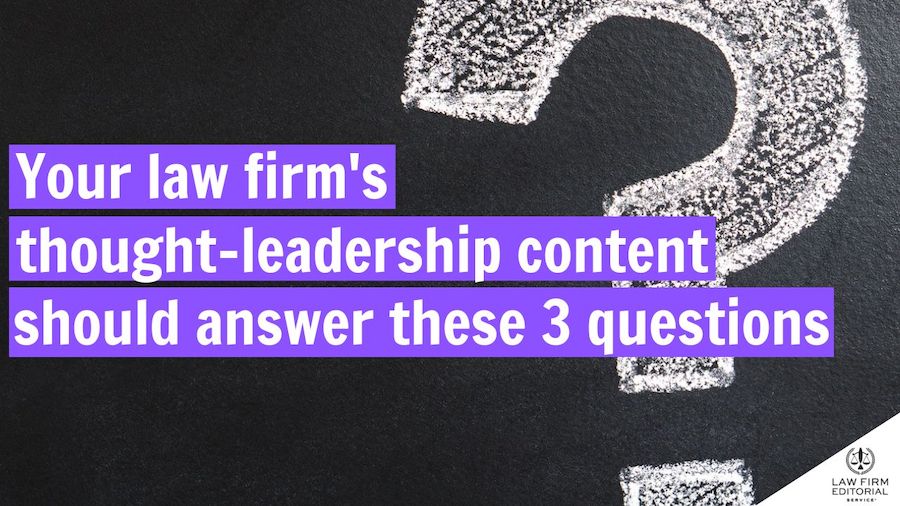Provide value to consumers of your thought-leadership content by telling them what developments in the law mean for them, and where they should go from here.
There are three questions you as an attorney should answer when you create thought-leadership content addressing new developments in the law, such as court decisions, proposed legislation, and administrative agency actions:
“What?”
“So What?”
“Now What?”
When you answer these three questions, you’ll be separating yourself from your competitors in the eyes of current and prospective clients and referral resources.
Here’s why.
Most attorney thought-leadership content is lacking in value
Thought-leadership content is one of the key ways that business-to-business organizations, including law firms, can market themselves to clients and referral sources.
For attorneys, the idea behind thought-leadership marketing is that by conveying your understanding of trends and core concepts in a particular area of law, you’re demonstrating to prospects and referral sources that you know what you’re talking about, and that they should come to you when they have a similar issue down the road.
It is one of the top ways for attorneys, especially those with business-to-business practices, to market their skill sets and experience.
Many attorneys and law firms know the power of thought-leadership marketing content.
But few actually create thought-leadership content that provides value to its consumers. Especially when it comes to discussing new developments in the law.
That’s because attorneys so often create thought-leadership content that only regurgitates what a court or administrative agency says. They do not devote much time or energy to explaining the impact of what was said.
And that’s where these three questions come in.
By answering these questions, you will inevitably provide value to the consumers of your content by telling them where they should go from here.
(Don’t worry—you need not telegraph to your audiences that you’re answering these questions. You need not have “What?”, “So What”, and “Now What?” headings in your thought-leadership content. Addressing these questions through the substance of your content will suffice.)
The three questions attorney thought-leadership content should answer
Let’s take the first question, “What?”
It is an easy question to answer. Explain to the consumers of your content, in plain English, what the development is that you’re writing about. What did the court say? What is the notable statutory language? What is the proposed regulation? What did the high-ranking government official say at an industry conference?
Just make sure you are explaining clearly and in non-legalese what actually happened. Many attorneys do not, which is likely to drive away consumers of that content.
The second question, “So What?”, requires a bit more analysis than the first question.
When answering this question, you’re beginning to put some daylight between you and your competitors who are crafting their own thought-leadership content regarding the same legal development.
That’s because you’re explaining to your audience why the development matters to them and why they should care about it.
At this point, you’re building a connection with your audience because you are turning the focus to THEM and what THEY need to know.
The third question, “Now What?”, is the cherry on top of the sundae.
If you are answering this question credibly and accurately, you are demonstrating knowledge and providing insights that reflect a deep understanding of your audience, their organizations, and their industries.
After all, you are explaining what they need to do now as a result of the legal development you are addressing.
You are mapping out for them how they can take advantage of new opportunities, or avoid new threats, created by that development.
You are guiding your audience through the new state of play caused by the development.
But you cannot do this if you do not know your audience. Your audience understands this. That’s why answering this question in your thought-leadership content is so important. It creates a connection with your audience that your competitors are unlikely to duplicate based on their superficial and lackluster thought-leadership content.
A key component of impactful attorney thought-leadership content
It is easy to see how, as you answer these three questions and add layer upon layer of analysis and guidance, your thought-leadership content becomes more impactful.
By answering these three questions, you are not simply reporting on the development.
You are demonstrating “thought leadership.”
As a result, your content will better resonate with the current and prospective clients and referral sources you are targeting with it. This typically leads to a higher likelihood that they’ll get in touch with you when they face legal issues that are the kind you can handle for them.
At that point, your thought-leadership content becomes revenue-generating content.
All because you answered these three questions when you crafted it.
Do you have any idea how much revenue your law firm is missing out on by its attorneys writing their own thought-leadership marketing content? Visit writelessbillmore.com for a free thought-leadership cost calculator.

